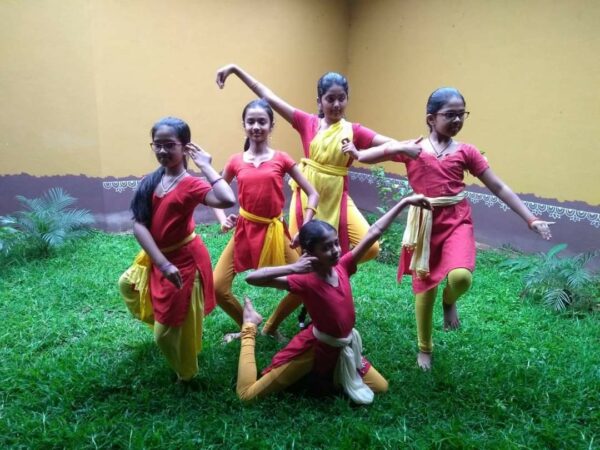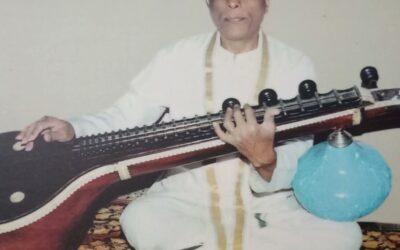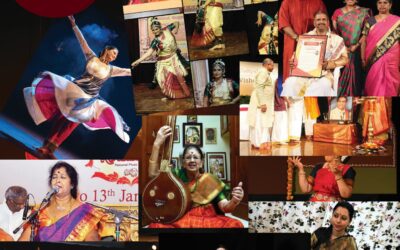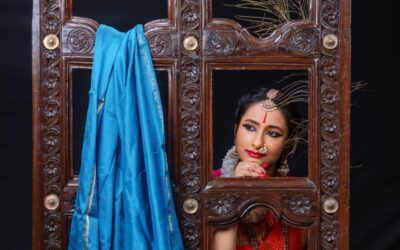Āhārya – a tradition to be passed on with reverence
– Supriya Shivarudrappa
Bharata says, “Bhushaṇa is the proper use of Alankāras and guṇas in accordance with the rasa, with an eye to rasouchitya”. One of the eloquent forms of communicating is through costumes, make up, jewellery, stagecraft and lighting collectively called Āhārya Abhinaya in the Nāṭya tradition. The beauty that is in the visual itself initiates the rasika towards the transcendental experience. The costume worn in any Indian dance form, be it mārgi or dēsi, is of immense importance- one that is time tested, traditional, naturally diverse and highly appropriate in conveying the necessary gesture. If our ancestors have worked so meticulously to celebrate the exuberance of an art form, they definitely have laid some meaningful traditions to be followed while practicing such an art form as a mark of discipline and reverence.

 This article intends to discuss the Āhārya- OFF the stage, the need for educating small and young students of classical dance on Indian traditions and inculcating in them the habit to dress in prescribed Indian attire whenever they are attending their dance classes or practicing the same elsewhere. The conventional education of today’s children is progressing on an imaginary platform called ‘comfort zone’ whereas, the ancient Indian ideologies preach that, in order to attain something profound in life, there is a need to get out of your comfort zone. These ideologies are true even in the 21st century by word and action. Your T shirt-track pants/casuals may be your comfort to dance in, but, a practice saree/salwar kameez with dupatta is pleasant to the eyes of the onlooker; it lets your skin breathe and promotes blood circulation; the dupatta tied to your waist makes you aware of your sutra/core, leading to right posture and its usage.
This article intends to discuss the Āhārya- OFF the stage, the need for educating small and young students of classical dance on Indian traditions and inculcating in them the habit to dress in prescribed Indian attire whenever they are attending their dance classes or practicing the same elsewhere. The conventional education of today’s children is progressing on an imaginary platform called ‘comfort zone’ whereas, the ancient Indian ideologies preach that, in order to attain something profound in life, there is a need to get out of your comfort zone. These ideologies are true even in the 21st century by word and action. Your T shirt-track pants/casuals may be your comfort to dance in, but, a practice saree/salwar kameez with dupatta is pleasant to the eyes of the onlooker; it lets your skin breathe and promotes blood circulation; the dupatta tied to your waist makes you aware of your sutra/core, leading to right posture and its usage.
There are students who say they are not used to wearing a bindi/kumkum on the forehead and just because it’s a rule in class, they keep a small dot with a pen and enter the class. The science behind adorning a kumkum on your forehead is to activate ‘āñja cakra’ –the centre of knowledge, intuition, awakening and envisioning. Wearing bangles is distracting is the next reason, but the constant friction with the wrist increases the blood circulation level. Not just this, every single practice has science and abundant benefits in Indian culture. If such is the significance of just the practice costumes, imagine the vastness behind the ON stage grandeur of a silk drape, the head adornments linked to cosmos, the anklets symbolizing the Śiva and Pārvati and so on. Spirituality oozes out of our Bhāratiya Samskāra. Any kind of sādhana for that matter is built on passion, discipline and sheer determination and not on ‘comfort zone’. To follow traditions is not punishment/rules but our responsibility because you are born in a country that celebrates its delighting, diverse and divine culture.
As Guru R Satyanarayana quotes, “Slavery to non-aesthetic convention hardly promotes the progress of art.” So, the next time we wear or insist students to wear the right practice costumes, let us be proud as honest ambassadors of our respective Indian Art; let us celebrate our nation in our deeds and constantly seek the sublime.
**********



